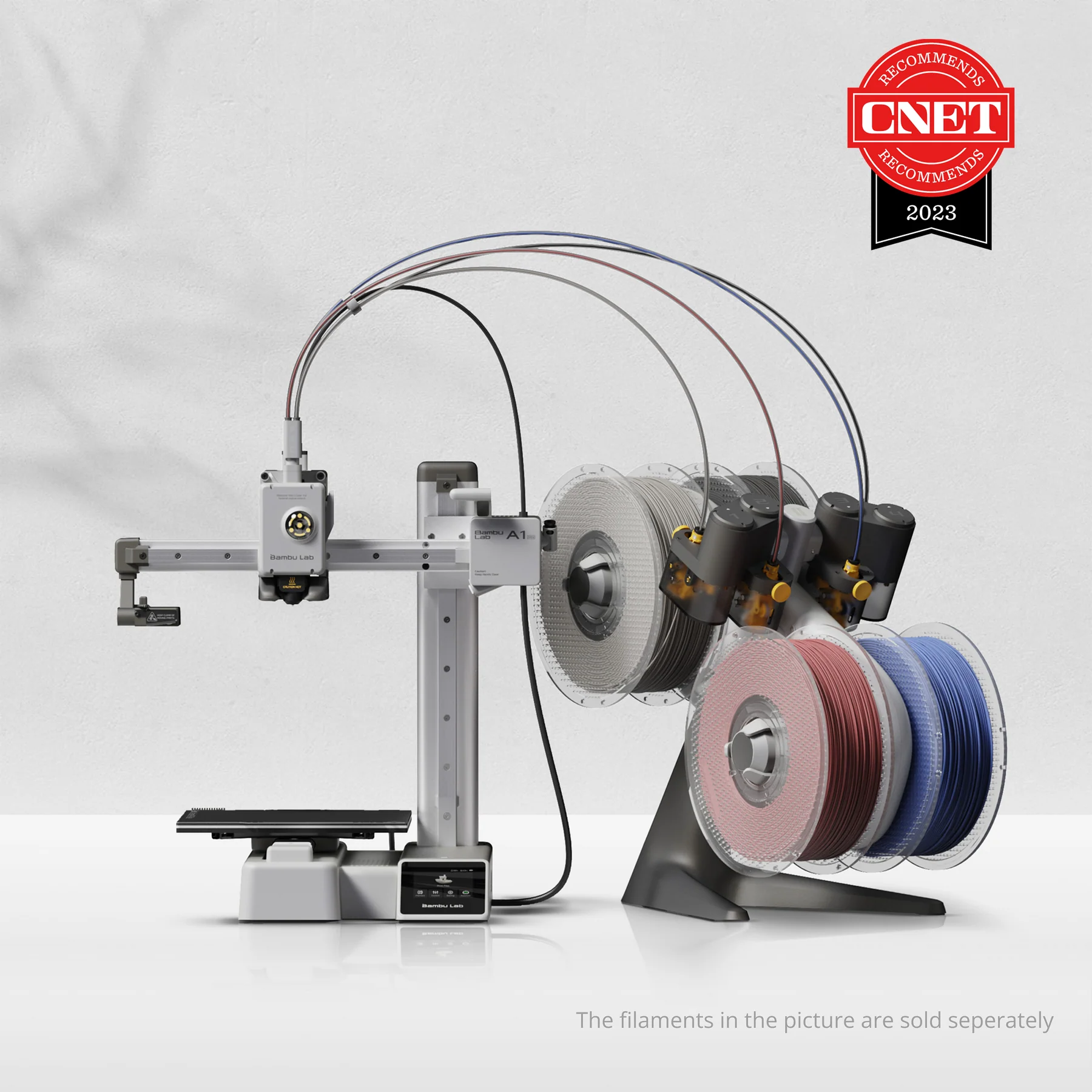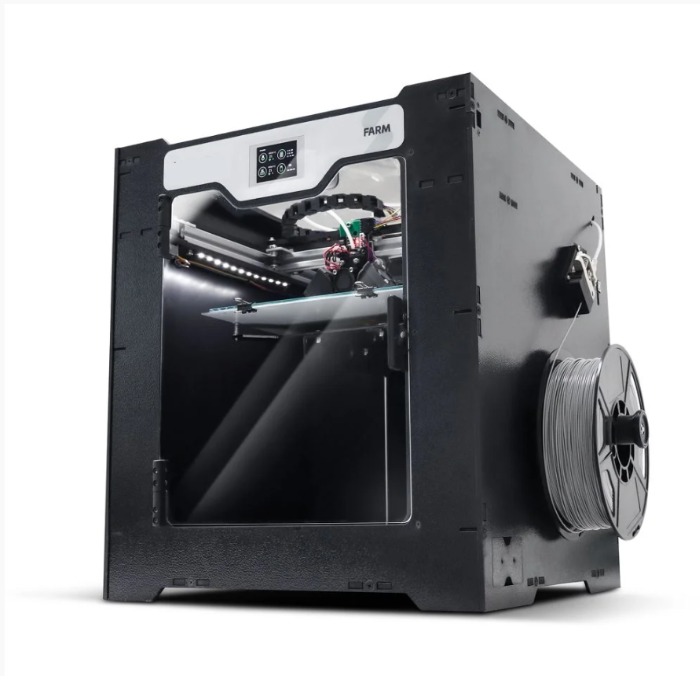Compare A1 Mini vs FARM
Comparison between the best 3D printers
Choose the best 3D printer at the best price. The cheapest 3D printers are here.
Buy a 3D printer here with 3D Fila.
 |
 |
|
| Model | A1 Mini |
FARM |
| Printing Material | Filament | Filament |
| Buy Filament for Bambu Lab A1 Mini | Buy Filament forSethi 3D FARM | |
| Estimated price | $549,00 | $1127,00 |
| Manufacturer | Bambu Lab | Sethi 3D |
| Release Year | 2023 | 2021 |
| Print Volume [mm] | 180x180x180 | 240x240x240 |
| Printer Size [mm] | 315x347x365 | 550x42x500 |
| Weight [kg] | 5,5 | 15,7 |
| Power Loss Recovery | YES | YES |
| Enclosed printer | NO | YES |
| Bed Leveling | Automatic | Automatic |
| Filament End Sensor | YES | YES |
| Bed type | Heated | Heated |
| Power supply system | Direct Drive | Bowden |
| Standard nozzle | 0,4 | 0,4 |
| Maximum Nozzle Temperature [°C] | 300 | 270 |
| Maximum Bed Temperature [°C] | 80 | 120 |
| Maximum printing speed [mm/s] | 500 | 80 |
| Filament holder | YES | YES |
| Camera for supervision | YES | YES |
| Recommended filaments | PLA, PETG, TPU, PVA | PLA, PETG, Tritan, Flex, ABS |
| Recommended slicers | Bambu Studio, Super Slicer, Cura, Prusa Slicer, Orca | Cura, Simplify, Slic3r |
| Maximum Resolution [mm] | 0,1 | |
| Processor | 32-bit Silenciosa | |
| Display | Touchscreen 2,4'' | Touchscreen TFT |
| Power Supply | 150 W | 450 W |
| Connectivity | Wifi, Bambu bus, Cartão SD | USB |
| Operating systems | Windows, Linux, Macbook | Windows, Mac, Linux |
| Date of registration in the system | 2024-04-10 | 2022-10-11 |
| Release date | 2023 | 2021 |
| Extra features | The Bambu Lab A1 Mini stands out not only for its impressive speed and automatic calibration, but also for its multi-color printing capability thanks to AMS Lite. This innovative system makes multi-color printing easy, making it accessible to everyone. AMS Lite, specific to the A1 Mini, supports up to four different materials simultaneously, providing creative freedom without complications. With comprehensive sensors for energy monitoring and recovery, a camera for timelapses and Wi-Fi control, the A1 Mini and AMS Lite together offer an intuitive and advanced 3D printing experience, ideal for materials such as PLA, PETG and TPU, and designed for simplicity and fast maintenance with quick-change nozzles. | Sethis Farm printer offers a generous 240 x 240 x 240 mm print area, ideal for large projects. Its intuitive touchscreen display makes it easy to operate, while the intelligent sensor prevents problems by detecting filament shortages or jams. Its power recovery feature allows you to resume printing after interruptions. It stands out for its 9-point optical auto-leveling and high-performance heated bed, ensuring accuracy and versatility on different materials. Its 32-bit electronics and silent drivers promote a smooth and efficient experience. In addition, the Farm has a closed cabinet, expanding the range of usable polymers, and a turbo cooling system to speed up the process between prints. The machine also offers practicality with a storage drawer and simplified software updates. |
| Support for multiple colors and materials (AMS and CFS) | YES | NO |
Notes * |
||
| Cost-benefit | 7 / 10 | 6 / 10 |
| Hardware | 4.2 / 10 | 2.5 / 10 |
| Tela | . | . |
| Print volume | 3 / 10 | 3 / 10 |
| Performance | 4 / 10 | 0 / 10 |
Conclusion |
| In comparing the Bambu Lab A1 Mini and the Sethi 3D FARM, several key factors contribute to their overall value propositions as 3D printers. The A1 Mini, priced more affordably, offers an impressive combination of speed, automatic calibration, and multi-color printing capabilities through its unique AMS Lite system. With a substantial maximum printing speed and straightforward maintenance, it is particularly appealing for users looking for a user-friendly experience without compromising on performance. Its compact footprint and lightweight design make it suitable for smaller workspaces, further enhancing its appeal. On the other hand, the Sethi 3D FARM provides a larger print volume, enhancing its capacity for handling larger projects. Its closed cabinet design and advanced features like 9-point optical auto-leveling ensure precision and flexibility across a wider range of materials. However, its higher price point may not represent the best cost-benefit ratio for many users, especially those who may not require its extensive capabilities or plan to work with larger prints. Ultimately, the A1 Mini is a better choice for those looking for speed, ease of use, and versatility in material handling at a lower price. In contrast, the FARM appeals to professionals needing robust features for larger-scale projects, albeit at a higher investment. Thus, the decision should rest on the user’s specific needs, priorities, and budget considerations. |

